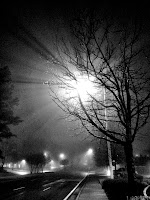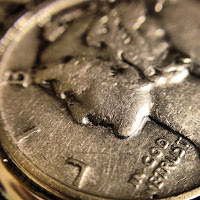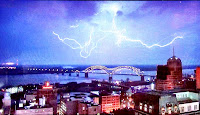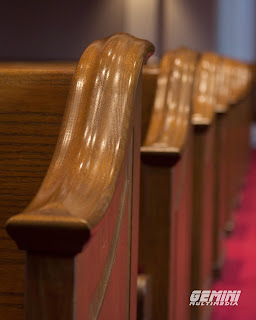I know, I know...If you're one of the millions who read this blog daily (heh heh heh), you know I'm bothered by two things: people who don't return their shopping carts AND the dependence on iPhones as a primary camera.
The primary reason is iPhones don't have optical zoom. I've seen decent shots where an iPhone was used but the digital zoom was not turned on. When the digital zoom is used, however, the shot can be ruined. And that is not just an issue with iPhones, it's an issue with any piece of photo/video equipment no matter how "high-end" the device is.
Shortly after I started working the graveyard shift (as a video editor) at Fox 13 in Memphis, a friend of mine said I should introduce myself to the station's chief meteorologist, Joey Sulipeck, which I did. It didn't take long before we realized we share a love of photography. We have had some great discussions on viewing photography as art, subject preferences and equipment recommendations. A couple of weeks ago we had lunch and I went off on a tangent about how I think people are putting too much faith in their iPhones as cameras. Joey responded in defense of the "iPhoneographers." We were having an evenly matched debate until he started showing me some of the pictures he had taken with his iPhone. I must admit...at that point he began to sway me.
As a result, I asked if I could interview him for this blog because, honestly, I was blown away by what he does with his iPhone's camera. I was also impressed by his technique. He understands that accessories and apps are needed to make it a truly effective substitute for a camera.
Enough of the background...let's dig in!
 |
| © Joey Sulipeck |
The Awesomeographist: Joey, w
hat inspires you? What is your favorite subject to photograph?
Joey: I LOVE capturing real moments. Photos that make you stop and study, reflect, think, marvel.
The Awesomeographist: I know you have some nice DSLR equipment, but it seems that your camera
of choice is your iPhone. How has your iPhone impacted your photography?
Joey: I've owned decent cameras for many years, but the iPhone
changed my shooting dramatically. Since I ALWAYS have it with me, I can
ALWAYS capture a moment that appears before me. And even more
compelling is that I can adjust it, enhance it, be creative with it in a
million different ways, and instantly share it across any platform I
choose. What good are beautiful photos if they're stuck forever on a
memory card because I don't have the time to sit and download massive
files? I'm now SURROUNDED by my images, and can instantly access a huge
catalog of past shots. It's changed everything.
The Awesomeographist: What determines whether you use your iPhone or your DSLR?
Joey: I use my iPhone 99% of the time to shoot now. If I have a special
pre-arranged shoot (model shots, family photo shoots) I'll use my DSLR
as it's a professional camera.
The Awesomeographist: Do you have a backup/disaster strategy should your phone break?
Joey: If my iPhone breaks.....I'll run and get a new phone. And I know this
for sure: the next model will have an even better camera.
The Awesomeographist: Do you use photography in your career as a meteorologist? If so, how?
Joey: I take pictures of weather events all the time now. Just as
revolutionary has been OTHER people with iPhones to take weather pics
and show them to me instantly. Take a moment to let that sink in: for
the first time in history, we're able to SEE in REAL TIME the weather
that's occurring from multiple viewing angles. That has a massive
ripple effect for studying weather and how it affects us.
 |
| © Joey Sulipeck |
The Awesomeographist: If you could choose any location and subject in the world to photograph, where and what would it be?
Joey: There's no "one" location I'd like to shoot because if I stop and look
around, I see fascinating things in every single place I'm standing.
Sometimes it's wide open and obvious....sometimes it's a super-close up
macro shot. That can often turn the mundane into the fascinating.
The Awesomeographist: What role, if any, do you see for film in the next 5 years?
Joey: The future of film is dim. It's just not practical: time consuming
& expensive is not a good combination. I think there will always be
purists who will prefer and use it....but it will be a very small
percentage of people.
The Awesomeographist: Describe the coolest photo you've ever taken...
Joey: Picking a favorite photo would be like picking a favorite child! And
what's a "favorite" of mine might not mean ANTHING to someone else.
Photography is an art, and art is personal. I love that about photos.
 |
| © Joey Sulipeck |
The Awesomeographist: Do you have a favorite photographer? Whose work do you most admire?
Joey: I don't have a favorite photographer, and I like that. Here's why. As a
kid, I wanted to be a professional photographer with National
Geographic. I realized early it was never going to happen because I
couldn't afford a camera, or more importantly, the film processing. But
now, ANYONE can be a photographer! And quite often, the most dramatic
photos come from unkno
wn shooters who happen to be at the right place at
the right time and (because they're all carrying smartphones) they just
happen to have a camera! I love that.
The Awesomeographist: Of all the cameras you have owned, which one do you favor the most?
Joey: Of all the cameras I've had? It's ironic, because I've invested
THOUSANDS of dollars over the years. But now, my favorite? My simple
iPhone. Just too easy and fun to use with remarkable results.
 |
| © Joey Sulipeck |

















































